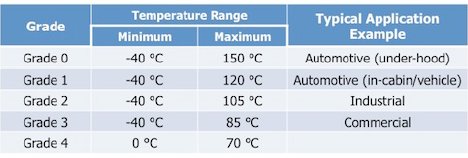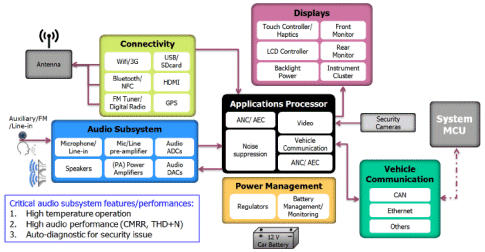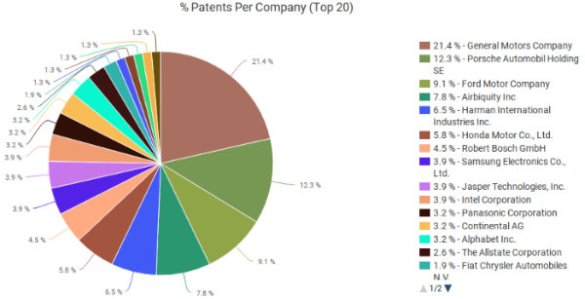The automotive market is driven in recent years by new consumer expectations. Ahead of them, the daily in-vehicle entertainment and connectivity experience, namely automotive infotainment, is becoming as important as traditional criteria: engine performance, safety and look of the vehicle.
Automotive infotainment refers to the hardware/software system combining multimedia entertainment (e.g. radio, CD/DVD for audio and video playback), driving information (e.g. safety, navigation and general car status) and connectivity (to smartphone, other cars and Internet). In parallel to the evolution of smartphone connectivity with vehicles, the Internet of Things (IoT) and Advanced Driver Assistance System (ADAS), it is expected that automotive infotainment is going to be more and more complex and remain a major focus in the future.
The audio subsystem plays undoubtedly a key role in the automotive infotainment system. This article describes the main automotive application constraints that have an impact on audio performances and thus consumer experience, together with design considerations to be taken care of at silicon Intellectual Property (IP), Systemon- Chips (SoC), application firmware/software and Printed Circuit Board (PCB) levels. Finally, this article highlights the critical performance parameter (common mode rejection) and noise tolerance specifications that are necessary for a given car audio converter IP in order to overcome the main automotive application constraints.
Automotive infotainment application constraints
Figure 1 shows the different modules of the automotive infotainment at system level. Each module has its specific design considerations and nonetheless has to comply with automotive application requirements:
- High temperature operation
- High robustness/reliability (i.e. AEC-Q100 stress test qualification)
- Resilience to various disturbances
- Auto diagnostic feature for security reason (as the driving security related information is communicated and controlled via infotainment system)
Figure 1: System synoptic of Automotive Infotainment application
Table 1 summarizes the application constraints and what has to be implemented and managed, at IP, SoC, application software and PCB levels, in order to deliver reliable high audio perceived quality and performances.

Table 1: Recapitulative table of automotive application constraints impacting audio performances and quality
Let us detail the key constraints mentioned above:
1. Noisy ground(s) voltage
The challenge of automotive electronics is that there is no clean common ground as the chassis or body of the car is used as reference ground. Therefore, special design care shall be applied in order to prevent the ground noise intermodulated or transmitted together with the useful signal. This is particularly critical when the builtin vehicle microphone is paired with either in-car or smartphone voice command personal assistants.
If the ground noise issue is not properly managed, ground loop problems can occur and audible noise can be generated.
For the built-in microphone, usually installed on the car roof, the cable linking it to the head unit of the infotainment system can easily be a few meters long. A Shielded Twisted Pair (STP) cable shall thus be used in order to avoid any additional noise induced by the cable itself.
As for the audio input devices, a ground noise cancelling circuitry shall be implemented. For audio Analog to Digital Converter (ADC), this problem can be managed with a dedicated input pre-amplifier stage with high Common Mode Rejection Ratio (CMRR), which will be detailed in this article.
2. Audio perception and spatialization
Automotive audio processing, perception and spatialization are hot topics in the audio engineering world, driven by customer in-cabin entertainment experience and requirements from the occupants. In order to provide highly perceived audio quality with noise reduction equalization (EQ) and/or spatialization processing, the audio converter in the system shall have high audio performances in terms of Signal-to- Noise Ratio (SNR), Total Harmonics Distortion and Noise (THD+N), inter-channel gain mismatch and Inter Modulation Distortion (IMD).
On top of this, some advanced spatial sound reproduction or active noise suppression technology in vehicle require an ambient sound recording from a built-in microphone array, which require automotive designers to carefully do the system design for avoiding noisy ground issues as mentioned above.
3. Security
As security related information (e.g. speed limit warnings or collision detection) is generally delivered through the same audio subsystem, it is extremely important to guarantee the information delivery even in case of system failure. Therefore, automotive power amplifiers normally incorporate built-in load diagnostics (short to ground or to battery, shorted load) and continuous protection against over voltage, temperature, etc. On top of this, the whole audio path shall be designed in such a way that the system can deliver not only the appropriate fault information but also the corrective action to the driver. In case of a fault detected on the main audio path, the delivery of the security information shall be ensured via an alternative output path (e.g. via a redundant audio interface or/and an audio output circuit).
4. High temperature operation
AEC-Q100 defines five different temperature grades that specify the ambient operating temperature range as part of stress test conditions for a given electronic device or Integrated Circuit (IC), as shown in Table 2. Devices for automotive applications, here the infotainment system, shall pass at least grade 1 qualification. Therefore, special design at IP and SoC level, package selection as well as PCB design and technology selection shall be done accordingly.

Table 2: AEC-Q100 temperature grades
Spotlight on the audio converter’s common mode rejection for overcoming the noisy ground issue
5. Common Mode Rejection Ratio (CMRR)
Common mode management of the audio signal is the key to overcome noisy ground issues in automotive applications. Audio signals go through long cables which are close to disturbance sources, such as the air conditioner, power wires, and many others.
In some cases, parasitic frequencies can be as high as useful signal, so before amplifying and sampling, unwanted parts of the signal have to be removed for maximizing audio quality. Hopefully, in most cases, these parasitic signals are common mode signals.
This means that these parasitics are identical on both signal wires:
- Between positive and negative for differential signals
- Between signal and ground wires for single signals
The high level of automotive disturbances forces to attenuate unwanted signals of a factor 10,000 (i.e. 80 dB) for guaranteeing a good signal processing. Common mode signals can be rejected by using differential amplifiers for only amplifying the useful signal. The ability of an amplifier to reject common mode is defined with the Common Mode Rejection Ratio (CMRR) as follows:
CMRR = GMC/GDiff
With,
– GMC, corresponding to common mode gain
– GDiff, corresponding to differential gain

Figure 2: Ideal resistive amplifier
Using an ideal amplifier (infinite gain) and ideal resistive elements (without mismatch) leads to a very high CMRR, because the common mode gain will be infinite.
However, real world is not ideal. Amplifiers will have a finite gain and resistive elements will have mismatch. Both non idealities lead to lowering the common mode gain and thus the CMRR. For Integrated Circuits (ICs), mismatch is mainly due to process variations during fabrication of the chip. Mismatch of resistors in ICs can reach about 1 % which implies a CMRR less than 40 dB. A solution for using resistor amplifiers while maintaining a high CMRR is to use Instrumental Amplifiers (IA) which are costly in both area and consumption.
A better way is to use capacitive elements as they are much less sensitive to process variations, and thus to mismatch. A full capacitor architecture is a really good solution for overcoming the CMRR automotive market requirement while maintaining the optimal trade-off between area and consumption.
Indeed, mismatch of embedded capacitors is much lower than that of resistors, and can easily be less than 0.1 % with proper layout guidelines. Using capacitive elements will thus lead to a CMRR of about 60 dB which is still not enough for the automotive market.

Figure 3: Full capacitive input amplifier with chopper system
Chopper systems may have to be used for reaching the 80 dB CMRR requirement of infotainment audio signal processing. A chopper system acts like a multiplier for common signal pushing away all the unwanted frequencies outside the audio bandwidth. An ideal chopper would have completely rejected the disturbances, but a real system only attenuates the unwanted frequencies of about 30 dB.

Figure 4: Chopper principle
Finally, combining the full capacitive architecture with a chopper system enables to match the automotive requirements.
CMRRINPUT_AMPLIFIER = CMRRCAPACITORS + CMRRCHOPPER = 60 dB + 30 dB = 90 dB
6. CMNT2 (Common Mode Noise Tolerance Template)
CMRR is often given at a fixed signal frequency or only given within the audio bandwidth (20 to 20k Hz), while out-of-band noise found in the noisy ground can also introduce audible noise due to aliasing with the internal sampling frequency of the audio converter.
From the example in Figure 7, we can see that the out-of-audio-band common mode noise level impacts more the audio performance than the noise in the audio bandwidth.

Figure 5: Example of a CMNT2
Beyond the CMNT2, it is also important to include in the specifications of the audio converter other noise tolerance templates such as PSNT2 (Power Supply Noise Tolerance Template), JT2 (Jitter Tolerance Template) and PDT2 (Period Deviation Tolerance Template), enabling the verification and guarantee of audio performance against the main noise propagation issues.
The sCODS100-N.11-Xenon audio CODEC from Dolphin Integration meets automotive requirements.
The sCODS100-N.11-Xenon is a high performance multichannel audio converter which combines a high CMRR with a strong resilience to power supply noise, clock jitter and data synchronization issues for preventing any performance drop. It benefits from 2 stereo ADC of 90 dB SNR and 3 stereo DAC of 100 dB SNR for supporting diverse input configurations (e.g. in-cabin microphone for voice command and phone conversation, and FM tuner and auxiliary audio input) and a 5.1 sound system.
In addition to high audio SNR, THD+N (up to -90 dB typically), CMRR (85 dB minimum) and Power Supply Rejection Ratio (PSRR of 90 dB) performances, the sCODS100-N.11-Xenon provides specification of all the different noise tolerance templates mentioned above. It also embeds a specific inter voltage isolation mechanism that enables independent start and stop of analog and digital power supplies, removing any constraint regarding the starting/stopping order and ensuring safe behavior of the audio converter during power-on and power-down of analog or digital power supply.
Conclusions
This article describes the automotive application constraints that have impacts on the car audio performances and perceived quality. It dives into specific performance parameters and noise tolerance specification of the audio converter itself. In order to overcome the noisy ground issue, a special input stage architecture of the audio converter is explained to improve the CMRR and the necessity to specify noise in frequency domain (beyond audio bandwidth) is highlighted.
The audio converter selected by fabless IC companies or system makers shall match the critical performances (e.g. SNR, THD+N, CMRR, IMD, gain mismatch) and provide needed noise tolerance specifications, for confidently addressing the automotive market and for enabling to provide valuable and efficient sound processing, such as audio spatialization processing, or audio connectivity.
Info courtesy @ Dolphin Integration







/cdn0.vox-cdn.com/uploads/chorus_asset/file/7759827/cortananissan.png)












 Chief Vintage – The 2017 Chief Vintage is the ultimate retro-vintage bagger, turning heads with its classic styling, iconic soft-sided saddle bags crafted from Desert Tan Genuine Leather – dripping in fringe and Indian Motorcycle nostalgia. Featuring the classic power of the Thunder Stroke 111 engine, the Chief Vintage is offered in Thunder Black and three gorgeous two-tone vintage color schemes. MSRP starting at $19,999.
Chief Vintage – The 2017 Chief Vintage is the ultimate retro-vintage bagger, turning heads with its classic styling, iconic soft-sided saddle bags crafted from Desert Tan Genuine Leather – dripping in fringe and Indian Motorcycle nostalgia. Featuring the classic power of the Thunder Stroke 111 engine, the Chief Vintage is offered in Thunder Black and three gorgeous two-tone vintage color schemes. MSRP starting at $19,999.